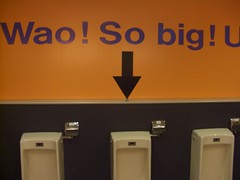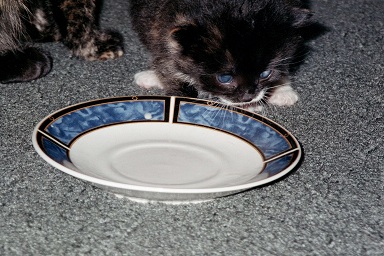- RT @Dave_Champion Obama asks DOJ to look at whether AZ immigration law is constitutional. Odd that he never did that with #Healthcare #tcot #
- RT @wilw: You know, kids, when I was your age, the internet was 80 columns wide and built entirely out of text. #
- RT @BudgetsAreSexy: RT @FinanciallyPoor "The real measure of your wealth is how much you'd be worth if you lost all your money." ~ Unknown #
- Official review of the double-down: Unimpressive. Not enough bacon and soggy breading on the chicken. #
- @FARNOOSH Try Ubertwitter. I haven't found a reason to complain. in reply to FARNOOSH #
- Personal inbox zero! #
- Work email inbox zero! #
- StepUp3D: Lame dancing flick using VomitCam instead or choreography. #
- I approve of the Nightmare remake. #Krueger #
Whose Line Is It Anyway? Why do some shows return from the dead?

Watching TV in the summer used to mean surfing channels of reruns, but lately there seems to be a slew of “new” shows that are repeating old ones. Networks and cable channels are bringing back previously popular shows such as “Whose Line is it Anyway?”, “Hawaii Five-O”, and “Dynasty”. While some people are thrilled that their favorite shows are back, a lot more of us are wondering why we need to keep rehashing the past.
These factors mean that TV stations are not very willing to take risks with new shows. A new drama or science fiction show can take millions of dollars to produce, and in some cases it will be pulled within a few episodes if it fails to catch on. When reviving an old show, a network has some guarantee that it will be popular. While not every remake catches on (Charlie’s Angels anyone?), a remake will usually attract enough interest to make the first episode a success.
The costs to produce these shows are also much lower than “new” shows. In many cases, networks already own the property rights to the show as well as contracts with many of the former actors, directors, and producers. In several cases, they also have access to props, costumes, and set pieces. Because of this, they can produce a pilot for a much lower costs than a “new” show.
Finally, advertisers like the idea of bringing back a show. While a network usually has to struggle to find sponsors for shows that don’t have a full season of Nielsen data to show, they can easily sell a show that advertisers are already familiar with. Furthermore, advertisers like that they know what to expect. Without seeing a single episode, an advertiser can accurately guess at the demographic that will be attracted to the show just by looking at the data from the original show. Because advertisers are familiar with the plot of these shows, they are also more willing to negotiate for product placement within the show itself. In some cases, advertisers have even suggested how their product could be incorporated into an episode before the first script is even finalized.
Related articles
Saturday Roundup
First, the shameless self-promotion:
If you want to see the glorious wisdom that is my Twitter feed, follow me on Twitter. I’m @LiveRealNow.
Please take a moment to subscribe to Live Real, Now by email. You get a choice between having all of the posts delivered to your inbox, or just occasional updates and deals. Both options get my Budget Lessons, free of charge, including exclusive access to articles that are not published anywhere else. Woo!
If you prefer to get all of you information and interaction on Facebook, become a fan!
And of course, there is always the wonderful RSS subscription.
Next, for the part you’re here for…
The Cute War.
Budgeting In the Fun Stuff guest-posted here a few days ago. The post was about her dog. Nicole asserted that her kittens were cuter than BFS’s pug. There is some personal risk involved for me, but my pets are cuter. The proof:
The Best Posts of the Week:
Frugal Dad discusses What to Do When Your Beneficiaries are Minors. We settled this by not making our minor children the beneficiaries. If we both leap off the mortal coil at once, my Dad gets the money. I trust him to take care of my kids with it. No, Dad, you can not work on my brakes.
Marko found a fascinating photo series of WWII war photos overlaying modern pictures of the same location. It’s kind of creepy in places.
My favorite dinosaur has a child has been reclassified as a child itself, not an actual dinosaur. That makes youthful me very sad.
Finally, a list of the carnivals I’ve participated in:
Both the Carnival of Personal Finance and the Yakezie Carnival included Selling Your Home: For Sale by Owner.
The Festival of Frugality has It’s Better to Buy a House than Rent.
If I missed a carnival, please let me know.
Twitter Weekly Updates for 2010-07-17
- RT @mymoneyshrugged: The government breaks your leg, and hands you a crutch saying "see without me, you couldn't walk." #
- @bargainr What weeks do you need a FoF host for? in reply to bargainr #
- Awesome tagline: The coolest you'll look pooping your pants. Yay, @Huggies! #
- A textbook is not the real world. Not all business management professors understand marketing. #
- RT @thegoodhuman: Walden on work "spending best part of one's life earning money in order to enjoy (cont) http://tl.gd/2gugo6 #
The Magic Toilet

- Image by tokyofortwo via Flickr
My toilet is saving me $1200.
For a long time, my toilet ran. It was a nearly steady stream of money slipping down the drain. I knew that replacing the flapper was a quick job, but it was easy to ignore. If I wasn’t in the bathroom, I couldn’t hear it. If I was in the bathroom, I was otherwise occupied.
When I finally got sick of it, I started researching how to fix a running toilet because I had never done it before. I found the HydroRight Dual-Flush Converter. It’s the magical push-button, two-stage flusher. Yes, science fiction has taken over my bathroom. Or at least my toilet.
I bought the dual-flush converter, which replaces the flusher and the flapper. It has two buttons, which each use different amounts of water, depending on what you need it to do. I’m sure there’s a poop joke in there somewhere, but I’m pretending to have too much class to make it.
I also bought the matching fill valve. This lets you set how much water is allowed into the tank much better than just putting a brick in the tank. It’s a much faster fill and has a pressure nozzle that lies on the bottom of the tank. Every time you flush, it cleans the inside of the tank. Before I put it in, it had been at least 5 years since I had opened the tank. It was black. Two weeks later, it was white again. I wouldn’t want to eat off of it, or drink the water, but it was a definite improvement.
Installation would have been easier if the calcium buildup hadn’t welded the flush handle to the tank. That’s what reciprocating saws are for, though. That, and scaring my wife with the idea of replacing the toilet. Once the handle was off, it took 15 minutes to install.
“Wow”, you say? “Where’s the $1200”, you say? We’ve had this setup, which cost $35.42, since June 8th, 2010. It’s now September. That’s summer. We’ve watered both the lawn and the garden and our quarterly water bill has gone down $30, almost paying for the poo-gadget already. $30 X 4 = $120 per year, or $1200 over 10 years.
Yes, it will take a decade, but my toilet is saving me $1200.
Breaking Bad: The Economics of Meth

In AMC’s “Breaking Bad,” Walter White plays the role of chemistry teacher turned meth producer and drug kingpin. While it certainly makes for good television to think about the profits available to someone willing to trade in illegal drugs, the mountain of money that Walter makes by the end of the series is actually not that unrealistic. Meth has a street value that approaches $30,000 dollars per pound. Not only that, but Walter displays a deceptively keen business acumen, especially for a chemistry teacher. A number of keen decisions allowed Walter White to become as successful as he has.
Production Costs
As any business owner knows, merchandise costs are a major portion of any operating budget. Mr. White keeps his profit margins robust in a number of ways. The first of these is by managing his production costs. When he started out in the business, Walter simply stole the majority of the required chemicals from the high school where he worked. This allowed for the product to be sold at a substantial profit when compared to producers who are required to invest more upfront.
Location, Location, Location
On top of his discounted production, Walter was able to stay ahead of the competition both literally and figuratively by utilizing his RV for production. Typically, meth is produced in a laboratory environment, which requires a building. This adds an additional cost of rent to the typical business profile. Walter, on the other hand, produced out of his RV in the early stages of his business’ growth, further increasing his profit margin.
Distribution
On the production side of the economy, a major consideration is distribution costs. While most of Walter’s competition used pricey, established lines of distribution for their products, he cut out the middle man by distributing his product with his team. This caused major disruptions to his business when his competitors tried to kill him. However, while he was able to accomplish this model, Walter was the beneficiary of increased profits. Then, when he killed his competition, he was able to return to the healthy margin he enjoyed previously.
Advertising
Many new products are launched with a full blown media campaign. This is a costly proposition. Walter, instead, relied on the quality of his product to speak for itself. This competitive advantage reduced the need for an extensive advertising budget. Furthermore, after a period of time, his product became a preferred choice by consumers everywhere. While he was required to distribute a few loss leaders at times, Walter kept the advertising costs down and profited greatly.
So, while it may seem like Walter White was simply a chemistry teacher who got lucky, it’s clear that he actually had a specific plan for his upstart business. By following a few standard economic principles, he was able to increase his margins at the crucial beginning phase of his business, and had established himself as a leader in the market when he chose to expand












